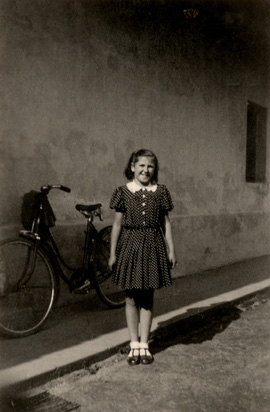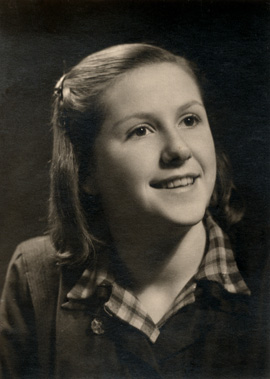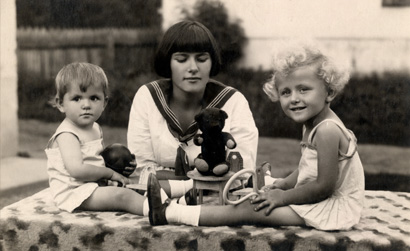Mrs. Erika Fürst
Today, Mrs. Erika Fürst lives in Murska Sobota. During the Second World War she lost most of her family.
The photo shows Erika’s grandparents Leopold and Regina Hiršl, her mother Terezija (married Fürst), aunts Irena, Ilona, Micka, Jolanda and Renata and uncles Nikolaj, Ladislav and Mirko.

Like many others Erika was deported to Auschwitz in 1944 at the age of 13, together with her mother and older sister.
When Prekmurje came under Hungarian rule in 1941, the then ten-year-old Erika attended primary school. Until 1943 she felt like an ordinary girl, no different from her friends at school. After 1943, however, her life and the life of her family began to change. They were forced to wear yellow Jewish stars, just like their coreligionists in Germany and elsewhere in Europe:
Children continued to go to school until autumn 1943, I think, when they ordered us to put on the Star of David. This identified us as Jews. Quite a few girls from school, friends, avoided me in the street because of the star I was forced to wear on my coat. I can say that Slovenian children weren’t ashamed to walk down the street with me… Well then it was often that we had to leave school early because of the air raids.
Erika and the rest of the survivors were sent to women’s Camp A and settled in the barracks. There they had their first premonition of what was waiting for them. Erika was hungry, thirsty, terrified and shivering with cold. She suffered terribly. She was given scraps of food, a piece of bread and a small tin plate of soup.

Sleepless nights alternated with days of slave labour:
We did hard work. We were loaded with bricks and forced to carry them in our hands several kilometres away. The road built with bricks from Auschwitz still stands today.
Although the German army was in great disarray by January 1945, that did not deter them from undertaking preparations for the so-called “Todesmarsch,” the death march. Erika made a split-second decision that she would not go, she did not want to leave her sister and mother behind. She jumped in the snow and remained hidden until the rest of the prisoners were gone. On either side they were escorted by armed soldiers with dogs:
I waited […] there, [and then] headed for the barracks where my mother was, and hid under her bunk. The Germans were still coming back, literally tearing the female prisoners from the bunks and shooting them…
Meanwhile Erika took care of her mother and sister. They were weak and sickly and between the Germans’ departure and the arrival of the Russian liberators, she kept them alive by searching for food and clothes in the abandoned camp:
[My] sister and mother were unable to stand on their feet. […]. I walked around the storage facilities with other prisoners [to see if] the Germans left any food. […] We collected water from the pool […] in which the Germans used to bathe during summer [… and] I found flour in one storage […]. I put it in my scarf and later made žganci with it. […] In another storage […] I also found [a tin of] cabbage. The tin was [too] big to lift, so I rolled [it] […] to our barracks.
After 1945 Erika, her mother and sister tried to lead an as normal life as they possibly could and already at the end of May the girls returned to school to complete the validation process.
